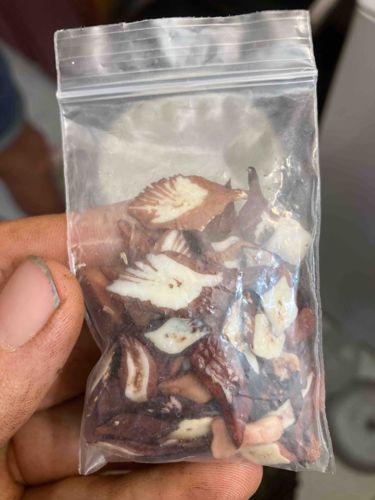
Fragmented Betel Nuts in Plastic Bag
The item consists of a small, clear, re-sealable plastic bag, commonly known as a Ziploc-style bag, containing what appears to be fragments of betel nuts (Areca catechu). The bag measures approximately 3-4 inches in height and 2-3 inches in width, holding a modest quantity of the fragmented nuts. The betel nut fragments vary in size and shape, suggesting they have been manually broken or roughly processed. The dominant colors observed are shades of reddish-brown and off-white/cream. The reddish-brown portions represent the outer husk or denser parts of the nut, while the lighter, off-white areas reveal the inner, fibrous, or fleshy endosperm. Some fragments exhibit a distinctive veined or marbled pattern, typical of the internal structure of a betel nut. There are no visible manufacturer's marks or specific branding on the bag or its contents, indicating an ungraded or informally packaged product. The condition of the nuts appears dried and brittle, with no obvious signs of mold or rot, suggesting they are either preserved or intended for immediate use. Given the nature of the contents, the item likely originates from regions where betel nut cultivation and consumption are prevalent, such as Southeast Asia, South Asia, or parts of Oceania. The manual appearance of the fragments points towards a traditional or small-scale processing method rather than industrial production. The bag itself shows minor creasing but no tears or punctures.
AI-Generated Appraisal Disclaimer
Estimated Value
$1-3
Basic Information
Category
Botanical/Agricultural Product
Appraised On
November 28, 2025
Estimated Value
$1-3
Item Description
The item consists of a small, clear, re-sealable plastic bag, commonly known as a Ziploc-style bag, containing what appears to be fragments of betel nuts (Areca catechu). The bag measures approximately 3-4 inches in height and 2-3 inches in width, holding a modest quantity of the fragmented nuts. The betel nut fragments vary in size and shape, suggesting they have been manually broken or roughly processed. The dominant colors observed are shades of reddish-brown and off-white/cream. The reddish-brown portions represent the outer husk or denser parts of the nut, while the lighter, off-white areas reveal the inner, fibrous, or fleshy endosperm. Some fragments exhibit a distinctive veined or marbled pattern, typical of the internal structure of a betel nut. There are no visible manufacturer's marks or specific branding on the bag or its contents, indicating an ungraded or informally packaged product. The condition of the nuts appears dried and brittle, with no obvious signs of mold or rot, suggesting they are either preserved or intended for immediate use. Given the nature of the contents, the item likely originates from regions where betel nut cultivation and consumption are prevalent, such as Southeast Asia, South Asia, or parts of Oceania. The manual appearance of the fragments points towards a traditional or small-scale processing method rather than industrial production. The bag itself shows minor creasing but no tears or punctures.
Related Tags
Explore similar items and categories:
Get Your Items Appraised
Instant estimates of your treasures with AI-powered instant appraisals